‘Elephants are not the only victims’: the lament of China’s ivory lovers
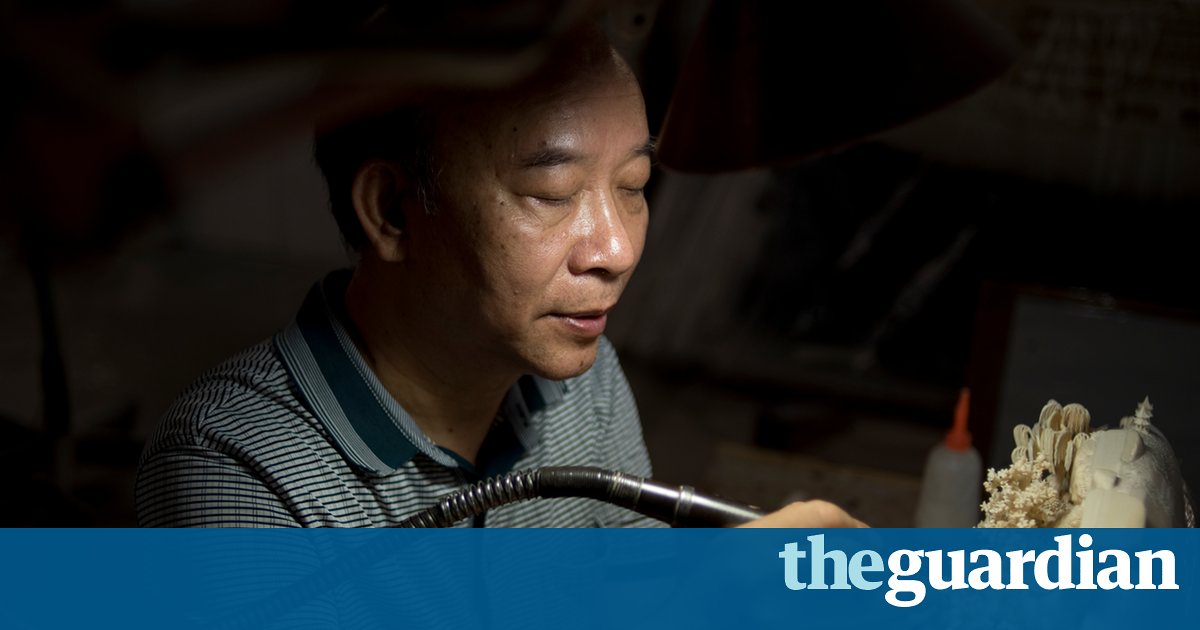
For years Chinas ivory carvers and collectors have been blamed for elephant poaching. Now their government is banning the ivory trade. How do they see their future?

 About this content
About this content In a tiny workshop at his home in the Tai Po district of Hong Kong, 84-year-old Au Yue-Shung shows me an ivory carving he has been working on for months. Measuring just 5×10 inches, Nine Sages in Mount Xiang depicts the 9th-century poet Bai Juyi and eight of his peers in full creative flow in Henan province, far from the imperial court that Bai once served. The point of the story is that the sages tried to maintain their integrity by staying close to nature and art, and away from the ugly politics of the time. This is a piece that Au created for himself rather than a client. It is his statement about life after going through many ups and downs.
Born during the Japanese occupation of China in the 1930s, Au joined Guangzhous Daxin ivory carving factory at the age of 13 as an apprentice. With only one years formal education and with no one caring to teach him, he taught himself drawing and carving in his spare time. Unable to afford drawing paper, he drew on toilet paper. His gift was soon recognised and by the late 1960s he had become a key carving artist at Daxin. Later, at the height of the Cultural Revolution, he decided that he had had enough of the political and artistic repression.
He first tried to flee China at the beginning of 1972. From Guangzhou, I hiked to Huizhou, then Shenzhen, he recalls. It took 13 days. I hid and slept during the day and walked after it got dark. I was arrested in Yantian [a port in Shenzhen], and was in jail for four months.

His employers refused to bail him out until they realised they needed him to make a complicated piece ordered by the government. At the time, ivory carving was officially encouraged as one of the few means to earn foreign currency.
Not long after he got out of jail, he again started planning his escape. I had to smuggle myself out of China even though the chance to succeed was only 30%, he says, because I had already been disgraced politically.
He made his second bid toward the end of 1972, when border controls were looser because of the cold weather. He again walked for 13 days, then swam for 10 hours from Shenzhen to finally reach Hong Kong.
It didnt take him long to make his name there. Each piece I did was sold before it was finished or immediately afterwards. Taiwanese loved my works. Some carvers tried sell their works by claiming to be my pupils, but they were not! He chuckles.
Yet he has never made a fortune from his masterpieces. One of his best and most valuable pieces is Platform Sutra, the size and shape of a large book, consisting of more than 20,000 Chinese characters and an image of Huineng, the legendary sixth patriarch of Chan Buddhism. It was the result of years of researching, brainstorming and fieldwork, as well as seven months carving. Au estimates that it is now worth at least a million Hong Kong dollars (100,000). But however much the collector paid him for it he says he cant remember it probably covered the material and labour only. I let him have it because he appreciates my art. Money is not everything, he says quietly.
His wife nods in agreement. He had this piece of ivory for over 30 years, but didnt quite know what to do with it, until Guan Weiqiang suggested something Buddhist.
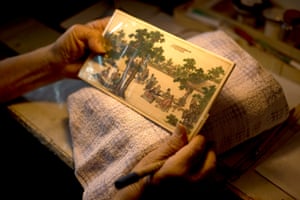
Guan, the man who ended up with Platform Sutra, wont say what he paid for it, but describes it as the most significant item in his collection. Many people want to buy it from me, but I wouldnt sell it. You simply cant evaluate it economically. Priceless. It is a masterpiece by a master artist I admire and respect greatly, he says softly as he pours a cup of tea at Geng Suan Tang, his furniture shop in south-west Guangzhou.
Fortysomething Guan, a businessman and celebrity chef known as Prince Dim Sum, says his collection of ivory is small alongside his carvings in jade, quartz, wood and bamboo root. Then he pulls work after work out of his walk-in safe, including a 60-layered ivory ball the largest in the world according to him and a miniature engraving of the Mona Lisa. It must all be worth a fortune.
Guan brushes the thought aside collecting has nothing to do with money. Collecting is art itself, a gift to appreciate beauty. You are what you collect. I was born with this gift.
But he admits that he hasnt always been so high-minded. Before I became a mature collector, I had more desire to own the objects than the ability to appreciate art. That desire is like a demon. Because of that, I was tricked into buying a fake antique Buddha statue in 1991. With time, he has formed a philosophy of collecting: study more than buy; buy expensive genuine art rather than cheap imitations; collect rare rather than generic artefacts. You cant let the demon [of greed] grow in you, he says. Because of this, I dont buy that much any more, particularly ivory carving.
But buying ivory at all is controversial, as is carving it. According to many wildlife charities, any trade in products made from elephant tusks, no matter how old, encourages poaching. By one estimate, more than 100,000 African elephants were slaughtered between 2007-14, mostly to satisfy demand for ivory in eastern Asia, particularly China. Daniel Stiles, an expert who investigated the trade in 2015, estimated that more than 90% of all ivory items sold in the country were illegal.
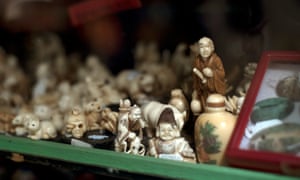
Last month, after many delays, the Chinese government announced that all domestic ivory trading and processing will be outlawed by the end of 2017, although doubts have been raised about how effectively this will be enforced and Hong Kong has a separate deadline of 2021. In the meantime, carvers can legally work on tusks imported before 1989, when the international trade in ivory was outlawed, but those stocks are dwindling. Au says he uses only 10kg of ivory a year at the most, all of which he purchased more than 30 years ago.
There is popular support for the governments move. Surveys in the countrys three biggest cities, Beijing, Shanghai and Guangzhou, found that 95% of the residents wanted the government to ban the ivory trade in order to protect African elephants. Celebrities ranging from actor Wang Luodan to property developer Wang Shi signed up for an International Fund for Animal Welfare (IFAW) poster campaign pleading: Say no to ivory products.
While agreeing that elephants should be protected, Guan doesnt want all ivory to be outlawed. Overconsumption [of ivory] would cause the elephants to become extinct. But artists like Au should be allowed to use the ivory from elephants natural deaths.
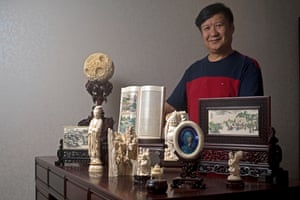
Guans idea of a demon that drives ivory collectors may sound fanciful. But I heard something very similar from a friend of mine, Chen Zhouqi, deputy director of the Guangdong Province Folk Art Rescue and Protection Centre, a branch of Guangdong Folk Art Association, whose goal is to protect all types of folk traditions, from folklores to traditional architecture. Not long after he started working full-time for the centre, Chen was given four small ivory carvings two from elephants and two from mammoths. The first gift was from Guan Weiqiang, whom he had interviewed for a book project on ivory carving. It was an ivory piece the size of a thumbnail, with one of Mao Zedongs poems, Snow, carved in it. I gave it away to a little boy I met at a story-telling contest in 2007, Chen says.
Wasnt that a precious gift to give a child, especially one hed never met before? You know, Chen says, I have a feeling that some artists gave me small gifts partly because they knew I was in a position where I could help to promote their works. It was almost like bribery kind of scary. And if you display them at home and keep looking at them, you could actually feel greed growing in you. You will desire more.
Like others I spoke to, however, he doesnt entirely understand why campaigners focus on ivory rather than other animal products. Elephants are not the only victims. There are others: whales, tigers, giant salamanders, and many more.
***
Zhang Minhui, like Au Yue-Shung, started his career at the Daxin ivory carving factory and is now an ivory carving artist with a high profile in China. He joined Daxin at the age of 19 in 1972, the year that Au smuggled himself to Hong Kong. His life has taken an altogether grander turn.
As well as running his own carving factory, Flower City Boya Craftwork Factory, he has roles in no fewer than 20 associations and organisations. Chairman of this, professor of that, he is most notably Guangdong provinces only National Inheritor of Intangible Cultural Heritage and Representative of Ivory Carving Artists.
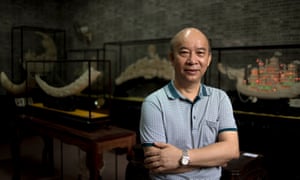
His ivory carving style is different from Aus. While Au only does miniature carvings in his tiny home studio with one knife, Zhang and his pupils create larger works with electric tools in his spacious factory. He wouldnt tell me how big his ivory stock is. When I ask him what he thinks about the government ban, he replies, Listen to the party, cooperate with the government, strive for support and carry on the tradition of ivory art. In other words, it will hurt but hell have to make the best of it.
He has expected this ban and prepared for a transition. Decades ago he diversified from ivory to carve other materials such as mammoth tusks and ox bones. We have saved some elephant tusks from before 1989 all legal and certificated, he says. As we are finishing our last legal ivory stock, we will use more ox bones and mammoth tusks.
Ox bone has its advantages, he says. Its much cheaper, and can be bigger. We have the technique to integrate many bones into one large piece to create carvings much bigger than tusks. Besides, it is the art of carving more than the materials that really matters and should be protected.
Dont many people still prefer ivory to ox bones or mammoth tusks? Yes, he admits. Its texture and hardness are perfect for carving. Its colour is more appealing to Chinese.
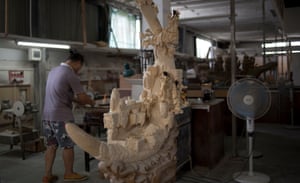
I think elephants should be protected, he continues. The key is stopping poaching in Africa. More should be done in Africa. Much more. Africa, not China, is the source of illegal elephant tusks. Yes, elephants should be protected, but so should the tradition and art of ivory carving. Honestly, we artists dont need a lot of tusks. Those from elephants natural deaths are more than enough for our creative works because each piece takes months, sometimes years, to finish.
You know what consumes the most tusks? he asks. Ivory jewelry and chopsticks. They are easy to make particularly chopsticks. Modern machines make them in large numbers quickly.
Even these have their collectors, like Szeto Alec, born in Guangzhou in 1958, and now a successful airplane salesman who frequently travels between China and the United States. To him the ban is imperious governance a dictatorial order similar to the one-child policy. The people have no say in it.
For the past 10 years Szeto has been collecting chopsticks from eBay, yard sales and estate sales. Particularly estate sales, he notes.
Why estate sales? So the life of the deceased can be continued! I dont buy expensive or artistic big ivory artifacts. I prefer used objects, chopsticks, cutlery, etc. Stuff that has been used has life in it. Each piece has a story. There is a sense of the continuity of life.
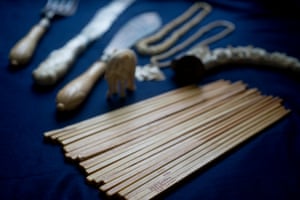
The concept of continuity is something that ivory sculptors and collectors mention time and again, though they express it in different ways. For Feng Suijun, a 39-year-old sculptor and art professor at Guangdong Peizheng College, patina is the word.
Antiques touched by hand often have a great patina a sense of history and life, he explains in a restaurant near his home in Guangzhou, before turning to his wife, Weng Shaoqiong, who is also a sculptor and art teacher. We should touch our ivory ball more to give it a patina.
Their ivory ball, a four-layer carving about the size of half a golf ball, was a gift from a deputy director of Guangzhou Folk Artists Association. He asked Feng to explore the possibilities for integrating traditional folk arts with modern design concepts, and gave Feng the ivory ball so he could experiment. Feng has just finished his design a pendant wrapped in silver.
It is a lot of pressure, Feng says, but Id love to integrate and modernise Guangzhous top three carving arts: ivory carving, wood carving and jade carving.
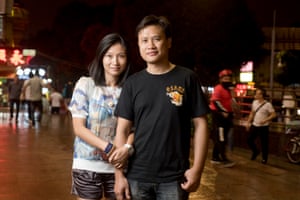
He wont comment on the governments latest move, but is still fuming about the IFAW campaign. It is hypocrisy! he insists. Each time I see Wang Shi staring from those ads, I feel disgusted. Cant help it. The look in his eyes is just disgusting. The other celebrities are not much better. You know, they are the ones who can really afford ivory products, not us.
I am not saying elephants should not be saved. My question is, why single elephants out? How are elephants more important than other animals? What about the whales killed and eaten by the Japanese? Also, there have been reports that some African countries have been appealing to the world to lift the ivory ban so their people can make a living. Are elephants more important than the human lives in Africa? Why cant we have a balance between wildlife conservation and a good use of natural resources? Can we find a way to make use of ivory while at the same time not endangering the elephants? I honestly think western media have gone to an extreme and Chinese media follow them blindly.
Without the ivory trade ban, would he try ivory carving? He specialises in wood sculpture and has never worked in ivory.
I would! he says firmly. You know what I think? It is true that elephants are endangered, but the art of ivory carving is in greater danger. Nowadays, how many people can sit still for hours to learn it?
Read more: https://www.theguardian.com/environment/2017/jan/06/elephants-victims-lament-china-ivory-lovers